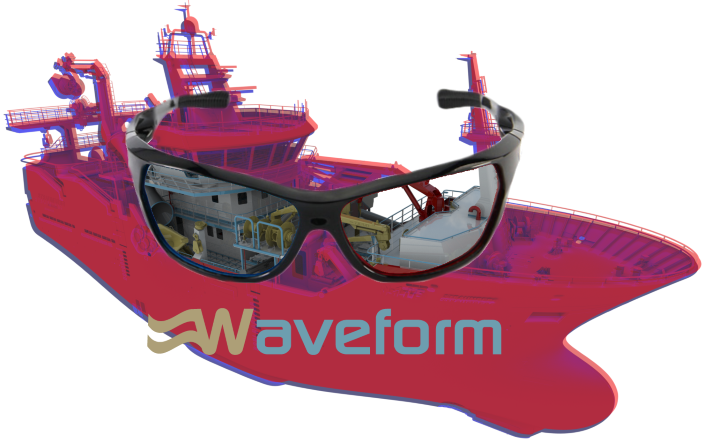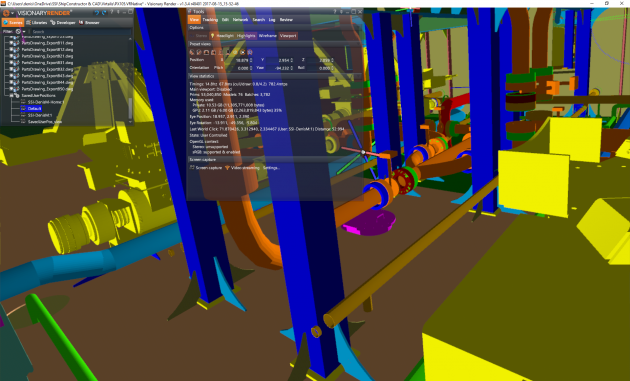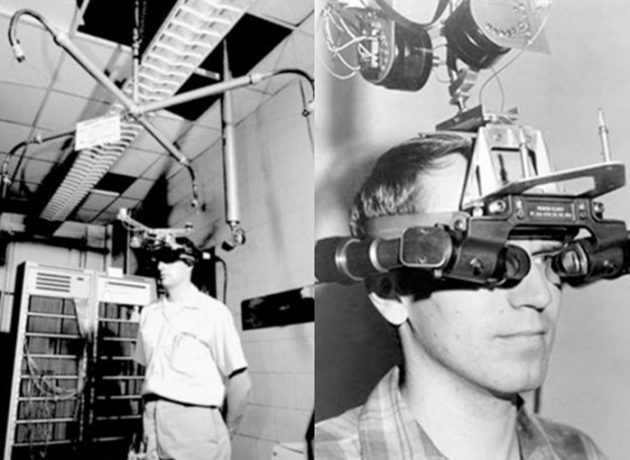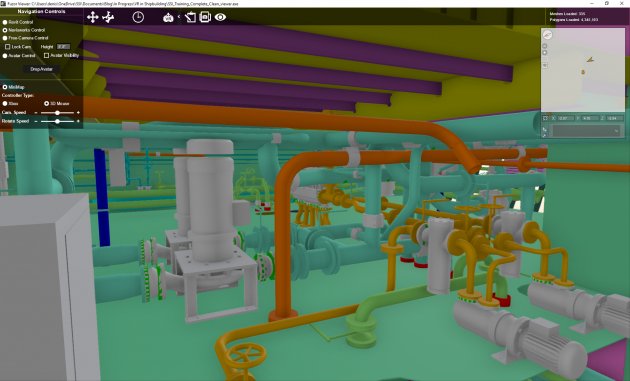
When I first got my first Virtual Reality (VR) headset over 2 ½ years ago, I, like most people, wondered how do I get my 3D model into VR? I quickly found out that without more investment in software or time I was not able to do much. This is when I started to research several options as well as started to engage with several experts in the VR community.
My Virtual Reality journey has been interesting and I have blogged about it throughout the years:
Industry will Drive Enhancements in VR
$20 Shipbuilding VR Experience
Virtual & Augmented Reality Systems I Experienced Recently
Virtual & Augmented Realty @ Autodesk University 2016
In this post I will list two solutions that have worked the best for me as well mention one solution you should stay away from unless you are in the business of software development and not shipbuilding. I should be clear that I have not tested all the possible solutions available; however, if there is one you would suggest I would love to try it out.
Gaming Engines – Unity
When I first started researching for a VR solution there were a lot of companies building their own VR solution using a gaming engine: Unity or Unreal. These gaming engines have VR support in essence out of the box. At that time SSI did not have very much experience in developing in these gaming engines but we thought, “How hard could it be to create a simple yet useful application?” This led us down the path to invest some development cycles in developing a VR solution that would read our data to create a seamless workflow for our users.
Relatively speaking it did not take us too long to create an application to show our 3D models in VR. However, from a user practical perspective the simple solution was not very useful. For our clients to use it they would need to learn how to use the gaming engine every time they wanted to create a VR scene. This was due to how gaming engines work as they are not designed to have a scene (3D model) continually updated. I could get a bit more technical; however, in summary the simple solution was not practical and if we wanted to create a seamless solution we would have to invest a lot more time.
My suggestion for any company which is focused on shipbuilding and not software development is not to waste your precious time and effort on creating a solution that will devour your $. With that said, I did see one SSI client who built their own VR solution with Unity and for them it seemed to be a good solution. However, I believe they are the exception to the rule.
VR Specific Software
The most viable workflow for most of you who want to invest in a virtual reality environment is to use applications which were designed for VR (and now AR) from the ground up. These solutions do have a cost; however, when compared to the amount of investment you would have to spend creating your own solution it is relatively small.
Throughout the years I tested several VR applications which are commercially available and had varying results. Here is what I was testing for in an out-of-the-box solution (in priority):
- Able to seamlessly leverage the geometric information from ShipConstructor to create a virtual scene by a typical designer (aka no VR expertise required)
- Ability to handle a significant portion of a ship model of at least ~40,000 parts. As anyone in shipbuilding knows, because of all the shape (curvature) in literally all our parts, graphical engines have a very hard time with dealing with the vast amount of complex parts. A typical shipbuilding part can be equal to about 10-100 AEC parts.
- Ability to transparently update the virtual scene effortlessly without losing any work in the VR environment.
- The ability to consume metadata from ShipConstructor in the virtual environment, e.g., properties, assemblies, user defined attributes, etc.
- Support various VR hardware.
Virtalis – Visionary Render

Contact: Dan D’Arcy d.darcy@virtalis.com

I have been working with Virtalis for a while now and was initially impressed with the performance of a 60m PSV in their VR environment over a year ago. Creating the VR environment was relatively seamless when using the SSI EnterprisePlatform which creates several formats that can be imported by Virtalis Visionary Render out-of-the-box. Once it was opened in Visionary render, I simply clicked the VR button and that was it. Visionary Render GUI is relatively easy to use and as mentioned it is responsive with the 60m vessel I was testing.
Even though the workflow was effortless, the downfall was that I was not able to get the ShipConstructor properties into Visionary Render. I did use some trickery to get the assemblies or part names transferred into Visionary Render. SSI and Virtalis are in discussions how we can improve the integration between the products.
The VR experience on my Oculus Rift was one of the better experiences I have had which is why it is one of my top choices. Virtalis has been in the business of VR for a long time with an impressive client base and it shows in their product. Their support for various VR hardware is too large to mention in the post so I will not even try. There was some that reminded me of the 1965 VR unit “Sword of Damocles”.

There are definitely my current recommendation for any company who has VR as a top priority.
Fuzor


Fuzor is the application which I have tested the least but it is showing real promise. The most interesting feature with Fuzor is that it can read Navisworks files. Almost every single SSI client uses Navisworks which allows for a very seamless workflow to support headset VR environments; you simply need to open the Navisworks file with Fuzor and you are good to go. It was unfortunate that ShipConstructor properties did not come across even though they were in the Navisworks file. At the time of this writing I am in discussions with them about this challenge.
The performance of Fuzor seems to be ok, but I have not been able to test larger projects at the time of writing this post. The GUI seems good, but I am having some trouble with repeating some movements and VR features such as measuring. I think it is just an education issue and not a software issue.
This solution also only seems to support head mounted displays which is great for some of you but may not be suitable for others who want a more versatile solution.
Fuzor does have a free viewer that is packaged with exports of their projects unlike most other VR applications which can be a huge plus. For anyone who has a HTC Vive or an Oculus rift you will be able to download the file below which is a Fuzor VR environment for the SSI training project.
Overview
| Solution | Fuzor | Unity | Virtalis |
| Performance on ship models | Handles ~8,000 parts (2 shipbuilding units) without any issue.
Untested on larger models
| Ok. Our solution probably was not optimized due to our lack of experience with Unity. | Handles a 60 m (!200ft) workboat without any issue
|
| Workflow | Seamless workflow using already generated Navisworks file
No ShipConstructor metadata | Requires users to have some Unity experience.
A recipe of instructions Can take a long time to generate the “game” with the 3D model. Workflow can be improved but requires a lot more development = time = $ | 3 step workflow
No ShipConstructor metadata |
| Investment | $2000-$5000 per year | A lot of development required. Probably more than just purchasing software | ~$1,000 for VR4CAD (Annual)
$? Visionary Render (what I tested) |
| Hardware Support | Personal headset (HTC Vive, Oculus Rift with Touch) | HTC Vive, Oculus Rift with Touch. Potentially others. | The most versatile solution I have seen with supporting almost every VR hardware including Caves, Screens, Joysticks, etc. |
Closing Remarks
Virtual Reality (VR) is a technology that has come a long way and its trajectory seems like it will provide a very compelling solution for shipbuilders.
Before VR is adopted throughout our industry we need it to be a natural extension of what we do in the same way as a lightweight viewer such as Navisworks is today. It should require no VR expert and it needs to be a simple push of a button to get a rich 3D model into a VR environment
For most shipbuilders the best investment will be to purchase a VR specific tool rather than developing their own VR application using a gaming engine.
The performance of the solutions commercially available today seem to handle our larger models which is a huge step in VR software and hardware.
I look forward to testing other solutions as well as seeing how the solutions I mention in this post progress in the coming year.
It is always hard to show how well VR works in a video or via images so I thought I would leave you with some videos of my kids helping me test some solutions. As you watch them you can see their reactions to the VR environment.
